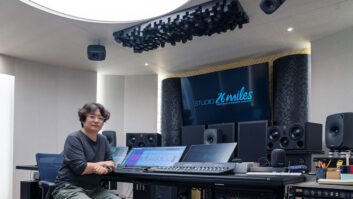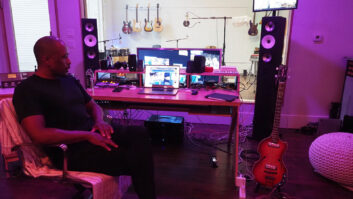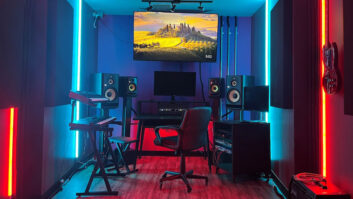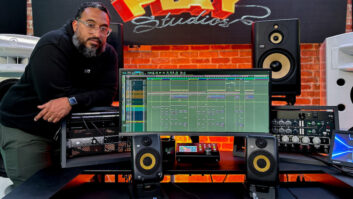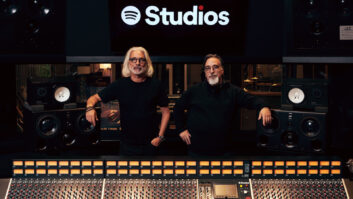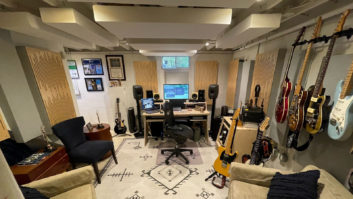You need new studio monitors. I know that because you’re reading this article. And admitting that there’s a problem is the first step in finding a solution. A curious phenomenon concerning studio monitors is that they never quite make it to the top of the shopping list. Somehow, in the quest for assembling the ultimate recording rig, you sidestepped the issue of getting some decent monitors. There’s always some cool processor, effects box, recorder, keyboard, drum box, guitar strap, microphone or leather couch that you just couldn’t live without, and like all natural creatures, we put off the necessities in favor of the luxuries.
There’s nothing exciting, glamorous or sexy about quality studio monitors. Leave the exaggerated bass and overstretched high frequencies to the big stereo store chains. If you’re looking for monitors that have a “warm sound” or “massive bass” or a little extra “sizzle” in the highs, then you may be fooling yourself into thinking your music is better than it really is. For example, if you’re working on a monitoring system with artificially boosted bass response, the mixes might sound great on that system, but when played on speakers with accurate reproduction, that huge low-frequency response will be lacking. Your mixes will never be right when your monitors (or room acoustics!) are lying to you.
As an analogy, let’s say you gained 20 pounds over the holidays, and it’s noticeable when you see yourself in the bathroom mirror. A fool would blame the mirror and correct the problem by installing a funhouse mirror that always reflected a svelte image.
And so it is with studio monitors. The whole point of a studio monitor is to provide a realistic picture of what’s on tape or coming from the console. If the signal you’re monitoring has low-frequency problems-i.e., air-conditioner rumble, breath pops, wind noise or mysterious oscillations-it’s nice to know that such flaws exist before you mix, or at least before you hear the product being broadcast to (or bought by) millions of listeners.
There are two separate and highly distinct schools of thought regarding studio monitors. The first is to mix on the ultimate, a high-powered system with absolute flat frequency response from 2 Hz to 30k Hz. The other approach is to mix on garbage speakers, with the idea being no matter what your audience listens on, it will surely sound better than what was heard on those terrible control room speakers. Both of these methods have their merits; however, what’s best for most people is a compromise representing a little of both.
It’s important to hear your creations on decent monitors that provide a reasonably truthful picture of what’s coming off the tape. At least this way, you have a reference or starting point from which adjustments can be made during the mix. At the same time, the garbage monitor theory does offer the advantage of hearing your mixes (preliminary or final) on something that might resemble what many consumers are listening to.
In days past, this was presumed to be some kind of two-way bookshelf speaker, usually with an 8-inch woofer, half-inch dome tweeter and the ubiquitous single-capacitorcrossover at 5 kHz. But these days, consumers are listening on every type of system, ranging from cheap portable Walkmans to massive CD boom boxes; home hi-fi systems can be anything from tabletop units to $100,000 audiophile setups; and automobile systems vary from 6×9-inch mono dashmounts to 140dBSPL cruisers. Mixing for television is getting tougher; the assumption that audiences have 3-inch mono speakers is fast disappearing with the rise of stereo TVs and the home theater market.
The playback medium for film mixing is getting somewhat more predictable, thanks to the virtual demise of the drive-in market (remember those horrible 5-inch speakers?) and the fact that most mono theaters at least had an Altec A7 behind the screen. However, these days, film mixers also have to consider the secondary market and need to be reasonably sure that their voluptuous multichannel surround mixes will translate when eventually played on cable, videocassette or broadcast television.
To make matters worse, you never know where your mixes will end up: MTV picks up a hot single that’s played over television sets; a film mix turns into a CD-ROM (i.e., A Hard Day’s Night) and comes out of 2-inch computer speakers; this list goes on and on.
In short, the idea of mixing for some preconceived notion about the end-user’s system will get you into trouble fast. This brings us back to the need for accurate monitoring. You should, of course, double-check your mixes on headphones, boom boxes, mono TV speakers and the like, but the bottom line is that you need an accurate monitoring reference that you trust.
DETERMINE YOUR NEEDS
This is the hard part. Finding the right studio monitors is no easy task, and there are dozens of compact near-field speakers available in prices from several hundred to several thousand dollars. But how much should you pay? The answer is to get the best monitors you can. This is not an area where you should try to save a few extra bucks-the quality of your audio creations is dependent on the quality of your playback system.
Some needs will be easy to determine. The physical layout of your studio may limit the size of your monitors; independent engineers who travel to different studios may want reference monitors that travel well. Or, you may have specific requirements, such as magnetically shielded speakers to reduce the visual distortion that occurs when large magnetic fields (i.e., speakers) are placed near computer or video displays.
The room/speaker interface is also important. Most small studio monitors are near-field types and are designed for listening at distances of approximately one meter. By placing the speakers in this close (or near) field, the proportion of direct sound reaching the listener is much greater than the amount of reflected sound retuning from the rest of the room. This near-field effect reduces (but does not eliminate) the acoustical signature of the listening environment, thus increasing the degree of monitoring accuracy. Therefore, monitors designed for near-field listening are designed with their individual components tightly spaced-or co-axially mounted-so the sound emanating from the various drivers reach the listener’s ears simultaneously.
Studio monitors that combine smaller speakers with a separate subwoofer system are increasing in popularity, the obvious advantage being the compact size of the main speakers (which is ideal in cramped quarters). While low frequencies are inherently less directional than mids and highs, some engineers find the spatial separation of the subwoofer systems to be disorienting. It’s a matter of personal taste and the geometry of the listening space-you’ll have to listen for yourself to decide what’s best for you.
Another growing trend is the use of powered speakers. These range from monitors whose amplifier section is mainly a convenience factor to monitors with multiple amplifiers that are chosen to match the characteristics of the individual speaker components. Such monitors are certainly more expensive than their nonpowered cousins, but they’re worth looking into, especially if your amplification system is also ready for an upgrade.
Before you spend money on monitors, do a little homework. Ask other engineers what they’re using; read reviews in magazines; check out the lively audio forums on PAN, CompuServe or AOL; make inquiries at trade shows; talk to other users at local AES, SMPTE or NARAS meetings; and, yes, even look at s. However, be wary of celebrity endorsements: I once read an interview with an engineer (whose work I greatly admire) who talked about his favorite monitors, an obscure German brand of consumer speakers. Thinking that these were the secret to his awesome mixes, I borrowed a pair. After mixing on them for two weeks, I still wasn’t used to them; I finally gave up and went back to my regular monitors. The moral here is that choosing monitors is a highly personal decision, and what’s right for someone else may not be right for you.
THE DREADED AUDITION
When I first discussed this article with Mix publisher Hillel Resner, he joked that when auditioning monitors in a retail environment, the first thing you need to do is yell, “Everybody shut up!” After a laugh, it occurred to me that he was right-not about the yelling part. It’s impossible to evaluate the nuances of competing monitors if there’s someone checking out guitar amps 10 feet away.
And before you go shopping, bring some reference material-CDs that you’re familiar with and/or tapes of some of your own favorite mixes. It’s virtually impossible to evaluate monitors without having some material you know as a reference point. I have a set of CDs for auditioning speakers, and they include orchestral, solo vocal, solo piano and various rock and jazz artists. I also have several test CDs of sine waves, which are useful for determining low bass performance, as well as checking the extreme top-end response. Some hints for the audition process:
- Don’t try to compare more than two pairs of monitors at once. A simple A/B test is hard enough to handle, without having to attempt an A/B/C/D…test.
- Don’t fall into the “louder is better” trap if you are switching between two speakers with different efficiencies. If necessary, adjust the gain or amp levels so that the speakers you’re comparing play at similar volumes when you switch.
- When listening to unpowered speakers, make sure that both sets of monitors are driven by the same (or same model of) amplifier. Power amps can have a noticeable difference on a speaker’s sound, and you need to eliminate any unnecessary variables when making comparisons.
- Be aware that your hearing can become fatigued over time, especially if you’re listening at a high volume If you’re having trouble focusing on what you’re doing, it may be a hint that you need a break.
- Make sure that your listening tests include playing material at low and height volumes. A good monitor will sound consistent at all levels.
- With studio monitors, the listening environment is everything. Listening to near-field speakers across the room is absolutely wrong. If you’re looking for speakers that are meant to be heard from one meter away, then you should listen to them in the near-field, and preferably seated, with the speakers at ear level. This will remove most of the acoustic effects of the room so you can focus on hearing the speakers.
- Most importantly, take your time. Don’t rush the evaluation. You shouldn’t feel pressured to make a quick decision. Auditioning studio monitors is an important process, one that requires a little time and advance preparation. But this small investment really pays off when you find the monitor that’s right for you.
